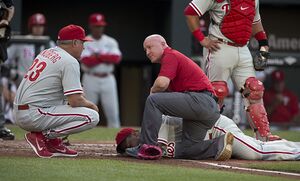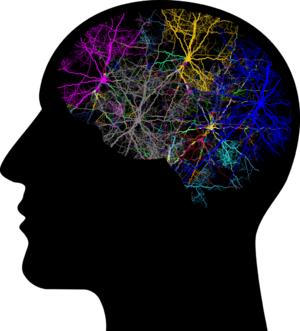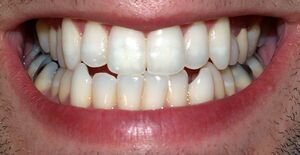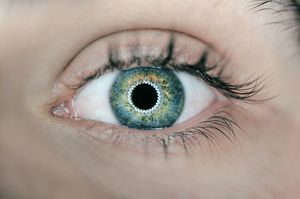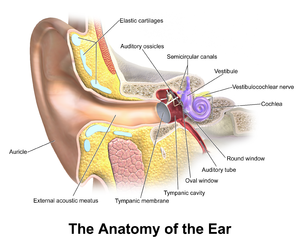Sports Injuries of the Head and Neck
Original Editor - Giulia Neculaes
Top Contributors - Giulia Neculaes and Kim Jackson
Introduction[edit | edit source]
Regular structured exercise is widely acknowledged for its numerous advantages. It boosts cardiovascular fitness, enhances muscular strength, and promotes increased flexibility, all of which significantly improve one's overall quality of life. Nevertheless, it is important to note that engaging in exercise also comes with a slight downside, namely an elevated vulnerability to sports-related injuries.
Despite the increasing rates of sport and exercise participation, injury rates are also increasing. According to the US Consumer Product Safety Commission, the number of injuries is on the rise: “From 1991 to 1998, there was a significant rise in injuries related to golf and swimming, with a staggering increase of 110 percent. Similarly, injuries associated with ice hockey and weightlifting saw a notable surge of 75 percent. Soccer injuries also experienced a considerable upswing, with a rise of 55 percent. Bicycling injuries followed closely behind with a 45 percent increase, while volleyball injuries saw a slightly lower rise of 44 percent. Lastly, football injuries witnessed a 43 percent increase during this period.”[1]
A research study revealed that a 20% probability indicates that one out of every five athletes is prone to experiencing an injury[2].
What is a sports injury?[edit | edit source]
A physical injury refers to any form of stress or strain on the body that hinders its proper functioning and necessitates a reparative process. On the other hand, a sports injury encompasses any type of injury, pain, or physical harm that arises from engaging in sports, exercise, or athletic activities. However, more severe injuries like head, neck, and spinal cord trauma are typically distinguished from common sports injuries such as sprains, fractures, and contusions.
Sports injuries predominantly affect the musculoskeletal system, which comprises the muscles, bones, joints, and related tissues like ligaments and tendons. Here is a concise explanation of the constituents that constitute the musculoskeletal system.
Anatomy background[edit | edit source]
The skull is composed of a total of 14 bones, with 8 of them being large and flat. These 8 bones are arranged in two pairs and 4 single bones, forming a container-like structure that encases the brain. The specific bones that make up the skull are the frontal, parietal, temporal, occipital, sphenoid, and ethmoid bones. In addition to these, the head also contains facial bones, teeth, eyes, ears, and the nose.
The neck comprises seven vertebrae, commencing at the base of the skull (C1) and gradually angling downwards as they extend towards the chest area, where they connect with the thoracic vertebrae.
Head concussion, contusion, haemorrhage, fracture[edit | edit source]
The most common catastrophic sports injury is the one that affects the head and neck, and it is also the leading cause of death in athletics. While the brain can be damaged by direct compressive forces, it is more vulnerable to injury from shearing stresses, which are often caused by rotational forces applied to the head. The most common athletic head injury is concussion, which may vary widely in severity. Intracranial haemorrhage is the leading cause of head injury death in sports, making rapid initial assessment and appropriate follow-up mandatory after a head injury. Diffuse cerebral swelling is another serious condition that may be found in a child or adolescent athlete, and the second impact syndrome is a major concern in adult athletes[3].
If the force applied is strong enough, it can cause fractures in the bones of the skull, potentially leading to the impingement of brain tissue. This can result in bleeding or haemorrhage within the skull. In the event of a blood vessel rupture between the skull and the brain, a clot or haematoma may form, exerting pressure on the underlying brain tissue. An epidural haematoma refers to a clot forming between the skull and the brain's protective covering, known as the dura mater, while a clot between the dura mater is referred to as a subdural haematoma. A haemorrhage in deeper layers can cause contusions or bruising to the brain tissue.
- Causes
The causes of head injuries include collisions with other athletes during contact sports, severe falls with impact to the head, and trauma from blows in boxing.
- Signs and symptoms
Head injuries can lead to various signs and symptoms, such as loss of consciousness, confusion, memory loss, and shock.
- Treatment
In the event of a head injury, it is important to immobilise the patient and elevate their head and shoulders in a calm environment. If necessary, stop any bleeding and seek immediate medical attention. Head injuries require prompt medical care, as failure to do so can result in permanent brain damage or even death.
- Rehabilitation
The rehabilitation process for head injuries varies greatly depending on the nature and severity of the injury. Even mild concussions can lead to post-concussion syndrome, which may persist for six months to a year. More severe injuries can cause a wide range of permanent symptoms. Treatment approaches depend on the clinician’s ability to differentiate among the various conditions associated with PCS (Pelvic congestion syndrome). Early education, cognitive behavioural therapy, and aerobic exercise therapy have shown efficacy in certain patients but have limitations in their study design. An algorithm is presented to aid clinicians in the evaluation and treatment of concussion and PCS and in the return-to-activity decision[4].
Neck strain, fracture, contusion[edit | edit source]
Injuries to the neck can have severe consequences, especially when it comes to fractured or broken vertebrae. On the other hand, neck strains are more prevalent and less severe, typically causing damage to the muscles or tendons in the neck. Contusions, which are bruises on the skin and underlying tissues of the neck, often occur as a direct result of a blow.
The prevalence of traumatic central nervous system (CNS) injury is estimated to range from 150 to 430 cases per 100,000 individuals for brain injury and 150 to 500 cases per 100,000 individuals for spinal injury. It is believed that 3% to 25% of these injuries are associated with sporting activities. Despite the common assumption that nervous system injuries are exclusive to contact and collision sports, they can actually transpire in various youth sports. The injuries that receive the most attention from the public are typically those that result in brain injuries[5].
- Causes
The primary causes of most neck injuries include abrupt rotation of the neck, severe falls, direct impact on the neck, and instances of concussion.
- Signs and symptoms
The symptoms include pain in the head, neck, and shoulders, a sensation of crackling in the neck, as well as a decrease in neck strength and mobility.
- Treatment
To safeguard the spinal cord, immobilisation is employed, while analgesics are administered to alleviate pain. It is crucial to promptly seek medical assistance for neck injuries, as they can have severe consequences such as long-term paralysis, impaired movement and coordination, and the development of calcification and osteoporosis. Fractures, in particular, can result in paraplegia and, in some cases, prove fatal.
- Rehabilitation
A brace may be advised for several weeks to immobilise neck strains. In instances of fractures, surgical pinning of the broken vertebrae with screws and the use of a neck cast may be necessary. After the healing process, physical therapy will focus on restoring range of motion, flexibility, and strength. To prevent certain neck injuries, wearing helmets or other athletic headgear and practicing proper technique are recommended.
Cervical nerve stretch syndrome[edit | edit source]
Cervical nerve stretch syndrome, commonly known as burner syndrome, occurs when the brachial plexus, a network of nerves in the lower neck and shoulder region, is stretched or compressed. This type of injury is frequently seen in contact sports such as hockey, football, wrestling, and rugby. Sports-related brachial plexus injuries are identifiable by a burning sensation that extends down the upper limb.
The outlook for the injury is typically positive, although a few athletes may experience a persistent form of the ailment, and there is a significant risk of re-injury. In exceptional circumstances, microsurgery may be necessary to repair nerve damage.
- Causes
A blow to the head or shoulder, particularly during a football tackle, bending the ear towards the shoulder with rotation (which compresses the cervical nerves), and hyperextension of the neck.
- Signs and symptoms
There is a severe burning pain that radiates from the neck to the arm and/or fingers. Additionally, there may be paraesthesia or numbness, tingling, pricking, burning, or a creeping sensation of the skin, as well as muscle weakness. These symptoms can last anywhere from 2 minutes to two weeks.
- Treatment
The recommended treatment includes applying ice and immobilising the neck area, taking anti-inflammatory medication, and using analgesics for pain relief. It is important to note that the burning and stinging symptoms may persist and even worsen. Ignoring the injury can lead to further damage to the peripheral nerves.
- Rehabilitation
Rehabilitation for cervical nerve stretch syndrome typically involves the implementation of physical therapy. After the initial healing period, the therapy focuses on enhancing the range of motion in the cervical region and strengthening the muscles in that area, with special emphasis on the muscles that support the damaged brachial plexus nerve. Utilising suitable protective gear, employing appropriate techniques, and engaging in upper-extremity strength training can effectively reduce the risk of sustaining such an injury.
Optimising the diagnostic process involves having a thorough understanding of the sport, comprehending the mechanism of injury, maintaining a high level of suspicion, and utilising ancillary tests like electrodiagnostics and imaging in an appropriate manner.[6].
Whiplash (neck strain)[edit | edit source]
A whiplash injury occurs when the neck undergoes sudden flexion and/or extension, typically resulting from a blow to the back of the athlete during contact sports. This force causes the head to rapidly move both forward and backward. Various soft tissues in the neck, such as intervertebral discs, ligaments, cervical muscles, and nerve roots, can be damaged, leading to symptoms like neck pain, stiffness, and limited mobility. During a whiplash incident, the hips, back, and trunk are the initial body segments and joints to experience movement. As these structures move forward, they also move upward, which compresses the cervical spine. Consequently, the head moves backward into extension, creating tension in the lower cervical segment. This movement of the cervical vertebrae causes separation of the anterior structures and severe compression of the posterior components, including facet joints.
In most cases, the long-term prognosis for whiplash injuries is positive with appropriate care. However, symptoms may persist, and there is a risk of re-injury to the neck.
Injuries to the lower cervical spine are commonly observed in cases of hyperextension, where the spine takes on an S-shaped curve. This type of injury typically happens during the initial phase of whiplash, before the neck reaches its full extension. However, when trauma accelerations are more severe, there is a higher likelihood of injuries occurring in the upper regions of the cervical spine. Our research findings contribute to a more accurate comprehension of whiplash trauma, which in turn can aid in enhancing the diagnosis, treatment, and prevention of such injuries[7].
- Causes
Sudden impact from behind, forceful crash with another player or equipment, direct hit to the head.
- Signs and symptoms
Discomfort and rigidity in the neck, shoulder, or between the shoulder blades. buzzing in the ears or unclear eyesight, irritability, and exhaustion.
- Treatment
The RICER (Rest-Ice-Compression-Elevation-Referral) routine, immobilisation using a cervical collar. If left untreated, whiplash injuries can result in persistent symptoms of pain, limited mobility, and decreased range of motion. Additionally, it can lead to the continuation or worsening of associated symptoms such as fatigue, sleep deprivation, memory and concentration difficulties, and depression.
- Rehabilitation
The use of a brace to immobilise the neck is common practice, but it is important to encourage early movement to prevent stiffness. Once the tendons, discs, and ligaments have fully healed, low-impact strength and flexibility training, as well as rehabilitation, should be implemented. While protective gear and warm-up routines can help minimise the risk of whiplash, it may not be guaranteed in rough contact sports.
It is recommended that rehabilitation be conducted in the same environment as prior to the injury in order to achieve more favourable treatment results.
Wryneck (Torticollis)[edit | edit source]
Torticollis, also known as wryneck, is a distressing neck injury that typically occurs after a sudden rotational movement of the head. This movement compresses the nerves in the neck, leading to muscle spasms, pain, and restricted movement. Although disc prolapse or irritation of the cervical spine can contribute to this condition, sudden injuries, such as those sustained during sports activities, often result from nerve compression or sprains in the facial joints. The neck is commonly immobilised in one position, frequently rotated to one side, and bent forward due to the contraction of the cervical muscles.
Numerous sports activities can cause this injury, and symptoms are usually first noticed upon waking in the morning. Torticollis with immediate onset is typically associated with facet joint issues, while slow-onset torticollis is often related to disc problems.
Fortunately, wryneck usually resolves within a week or less, although the painful spasms can temporarily hinder daily activities. While a chronic form of this condition does exist, most individuals can expect a full recovery unless there are more severe underlying conditions.
- Cause
The sudden rotation of the head in contact sports, a fall that results in a sudden twist in the neck, a direct blow to the head causing sudden twisting.
- Signs and symptoms
Symptoms include pain and stiffness, loss of motion, and the neck may become stuck or frozen in one position.
- Treatment
The neck should be immobilised with a brace or supporting cervical collar. Anti-inflammatory medication and ice can be used to reduce inflammation. If left untreated, wryneck can worsen and become chronic. This condition may indicate damage to the cervical vertebrae, cervical discs, or associated nerves and joints, which would require medical attention.
- Rehabilitation
It is crucial to determine the cause of the injury and rule out any serious underlying conditions that may require surgery or major medical intervention. Afterward, a physical therapist may utilise an infrared heat lamp and massage the cervical muscles to restore range of motion in the injured neck. Wearing protective headgear, engaging in upper body and neck strength training, and paying attention to proper athletic technique may help decrease the likelihood of this injury.
Teeth[edit | edit source]
Athletes who participate in sports where a ball or puck can hit their face are at a high risk of tooth injuries. These sports include football, hockey, and lacrosse. The most common types of injuries are fractured, displaced, or knocked-out teeth. Tooth injuries often occur alongside other head and neck injuries, such as concussions, bruises, and jaw-joint problems. Teeth can be chipped or knocked out completely by a ball or bat. If a tooth is knocked out, it should be cleaned and replaced in its socket as soon as possible to avoid rejection by the body. While tooth injuries can be painful, they usually do not threaten an athlete's career or performance if they receive proper medical and dental care. The prognosis for a knocked-out tooth is good if it is replanted within the first thirty minutes of the injury, but after two hours, the prognosis is poor due to tooth rejection and root re-absorption.
- Causes
Teeth can be struck by a ball, puck, or any other projectile. They can also be directly hit by equipment such as bats, sticks, rackets, and more.
- Signs and symptoms
Signs of teeth injury include mouth pain, loose teeth, and bleeding from the mouth.
- Treatment
If a tooth has been knocked out, it should be washed in saline and firmly replaced in the socket. The mouth should be rinsed, and analgesics and ice can be used for pain relief. Prompt medical attention is necessary for any tooth injury. Swallowing a tooth after an injury is dangerous, as is the risk of infection if the injury is not properly cleaned and attended to.
- Rehabilitation
The rehabilitation process for teeth injuries depends on their nature and severity. Chipped or fractured teeth can be repaired and bonded by a dentist, and lost teeth can be replaced. The athlete should avoid activities that put the teeth at risk until complete healing has occurred. Using a mouth guard, especially a custom-fitted one, can help protect the teeth during high-risk and contact sports.
Eye[edit | edit source]
Eye injuries are a serious matter and can occur in many sports, especially those involving a ball, puck, stick, bat, raquet, or fencing foil. Basketball, hockey, netball, and baseball are the sports that cause the most eye injuries, while track and field, swimming, gymnastics, and cycling carry a lower risk. It is important to protect the eyes from excess ultraviolet radiation in sports like skiing and mountaineering. Even minor eye injuries can lead to vision impairment, and complications can result in visual deficit or loss. The prognosis for eye injuries varies depending on the nature and severity of the injury. Minor injuries that do not damage underlying structures in the eye can heal with proper attention. However, more serious injuries, particularly penetrating injuries, can result in permanent visual loss and must be treated aggressively as soon as possible.
- Causes
Blunt trauma to the eye can occur from equipment or direct contact in wrestling, while penetrating injury to the eye can result from radiation damage due to sun overexposure.
- Signs and symptoms
Signs of eye injury include blurred or absent vision, pain or sensitivity in the eyes, and obvious trauma such as bruising or bleeding.
- Treatment
Immediate treatment for an eye injury includes applying a cold compress and avoiding pressure on the eye. It is crucial to seek immediate emergency medical care for eye injuries. Failure to do so can lead to visual impairment, deficit, or permanent loss, especially if ocular haemorrhaging occurs as a result of the injury.
- Rehabilitation
The rehabilitation process for an eye injury varies greatly depending on its nature and severity. Minor injuries typically heal on their own, while more serious injuries may require ophthalmic surgery and extensive rehabilitation. To prevent such injuries, it is advisable to wear eye protection, such as safety goggles, helmets with eye shields, and other protective gear, during sports activities like cricket, wrestling, basketball, and racquet sports, including tennis.
Ear[edit | edit source]
Injuries to the ear can occur due to various factors, such as direct trauma from objects like balls, pucks, sticks, or blows in boxing. Infections, like swimmer's ear, can also lead to ear injuries. In athletic events, cuts, lacerations, bruises, and swelling can affect the ear, especially in contact sports. While the eardrum can be ruptured, this type of injury is uncommon in sports. It is important to note that sports injuries usually affect the outer or middle ear rather than the inner ear, where important structures like the cochlea are located. One example of such an injury is the cauliflower ear, which is caused by repeated blunt trauma resulting in a haematoma between the ear's cartilage and perichondrium. Fortunately, most athletes who experience ear injuries can expect a full recovery. However, in cases of a ruptured eardrum, partial or total hearing loss may occur. Therefore, seeking prompt medical attention is crucial for such injuries.
- Causes
Causes of ear injuries can include blows to the ear from balls or other projectiles, sudden pressure changes causing a ruptured eardrum, and trauma from boxing blows.
- Signs and symptoms
Signs of an ear injury may include bleeding and swelling, hearing loss or ringing in the ears, and dizziness and loss of balance.
- Treatment
If bleeding occurs, it is important to apply direct pressure. Additionally, placing sterile cotton in the outer ear can help keep the inside of the ear clean. It is crucial not to ignore ear injuries, as they can have serious long-term consequences for hearing. Ruptured eardrums can also lead to infection, which can have potentially serious implications.
- Rehabilitation
Rehabilitation for ear injuries varies depending on the specific injury. Cuts and abrasions to the ear, as well as a cauliflower ear, typically heal with minimal medical attention. However, a ruptured eardrum requires special care to avoid infection. Ear infections, common among swimmers, may require antibiotics and a period of time out of the water until the condition is fully resolved. In contact sports, the use of helmets or other headgear can help prevent direct trauma to the ear.
References[edit | edit source]
- ↑ Brad W. The Anatomy of Sports Injuries. Second Edition. Chichester, 2013
- ↑ Joshua D.R., Stuart J.C., Rod W., Morgan D. W., Ryan G. T., David A. O., Modeling the Risk of Team Sport Injuries: A Narrative Review of Different Statistical Approaches. 2019. Available from: https://www.frontiersin.org/articles/10.3389/fphys.2019.00829/full
- ↑ Cantu R. C., Head Injuries in sport. 1996. Available from: https://bjsm.bmj.com/content/30/4/289.short
- ↑ John J.L., Harkeet S., Barry W. Rehabilitation of Concussion and Post-Concussion Syndrome. 2012. Available from: https://journals.sagepub.com/doi/abs/10.1177/1941738111433673
- ↑ Mark R. P., Robert C. C., Head and neck injuries in young athletes. 2000. Available from: https://www.sciencedirect.com/science/article/abs/pii/S0278591905702337
- ↑ Stuart M.W. Assesment and rehabilitation of the athlete with a “stinger”: A model for the management of noncatastrophic athletic cervical spine injury. 1998. Available from: https://www.sciencedirect.com/science/article/abs/pii/S0278591905700673
- ↑ Manohar M.P., Jacek C., Kimio N., Jonathan N. G., Lawrence B. B., Jiri D. Mechanism of whiplash injury. 1998. Available from: https://www.sciencedirect.com/science/article/pii/S0268003398000333
